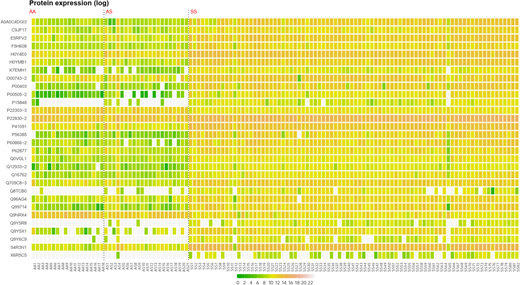Abstract
Annually, there are 312 000 births with Sickle Cell Anemia (SCA), which has been recognized as one of the most common inherited conditions in Africa and is currently emerging as a condition of prominence in much of the developed world due to migration patterns. Despite its growing importance, there has been a significant lag in the application of emerging methodologies to its research, in particular to support the discovery of disease-associated markers of potential implication in therapeutics and informing a more comprehensive understanding of the condition. To bring SCA in line with cutting-edge 'omics research, we conducted a study applying advanced mass spectrometry methods for the comprehensive characterization of the protein profiles of erythrocyte membranes. One hundred and twenty participants of confirmed Hemoglobin (Hb) phenotypes HbAA (18), HbAS (21) and HbSS (81) were enrolled from the Muhimbili Sickle Cell Programme in Tanzania. All consented individuals were confirmed to not be on hydroxyurea treatment and not having received a blood transfusion in the preceding 3 months. Whole blood was collected and mixed in 10 ml EDTA vials sent within 72 hours to the Target Discovery Institute (TDI), University of Oxford, UK. Once received, packed erythrocyte fractions were isolated and underwent a series of wash steps followed by erythrocyte lysis and the isolation of the ghost membranes by ultracentrifugation. The ghost cells were then prepared for liquid chromatography mass spectrometry (LCMS) analysis using a novel published method. Proteomics analysis on a Thermo Scientific Q-Exactive High Field MS identified 2,288 membrane or membrane associated proteins of which 1,605 showed significant difference between at least two of the Hb phenotypes with fold changes of up to 22. Specific comparisons identified 1,286 proteins showing significant (p value cut-off, 0.05) changes in expression between the HbAA and HbSS groups; 1,248 between the HbAS and HbSS groups and 278 between the HbAA and HbAS groups. A summary of 30 markers have been presented including a range of proteins of potential therapeutic impact. These were selected based on their ranked significance following statistical analysis, the overall distinction seen between the controls and the HbSS group and the robustness of their identification. The results obtained show significant changes in the presence or absence as well as levels of numerous proteins in the HbSS population compared to controls. This research is a significant contribution to the field of SCA research and forms the foundation to direct further study on the sickle erythrocyte membrane. The large number of proteins identified to be of association to individuals' Hb genotypes represents a significant breakthrough and could contribute to a better understanding of the pathophysiological mechanisms involved in the disease.
No relevant conflicts of interest to declare.
Author notes
Asterisk with author names denotes non-ASH members.


This feature is available to Subscribers Only
Sign In or Create an Account Close Modal